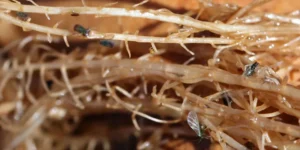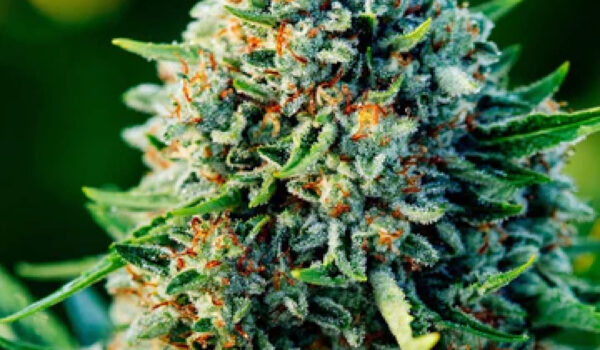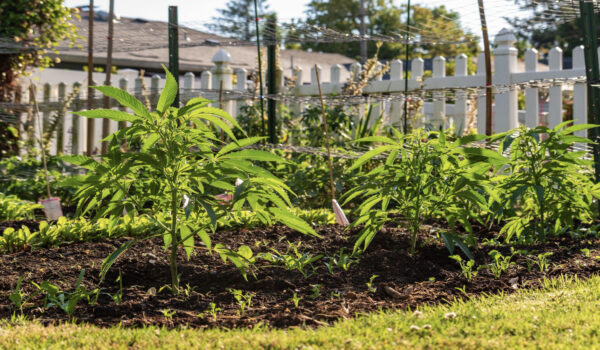by Rincon-Vitova Instectary

Root Aphids (Pemphigus populivenae)
Root aphids feed on the root system, sucking so much sap that the plants do not receive proper sustenance. Leaves turn yellow and little new growth occurs. They can move from plant to plant via the drainage holes in pots, or through irrigation water that drains from one pot to another. Root aphids tend to congregate on the outer edges of the root ball.
Identification
Oval soft bodies (tear-drop, pear-shaped), with Short legs & antennae
Root aphids can be winged or non-winged & come in a variety of colors
They may be misidentified as mealybugs (covered with white wax) but are generally smaller than mealybugs.
Life Cycle
Root aphids overwinter as eggs on alternate hosts.
They hatch and reproduce asexually, which leads to rapid pest explosions.
The winged version forms and leaves when the colony is too large.
Monitoring
Early detection is critical, as root aphids can be difficult to diagnose and observe
Symptoms Above Ground:
Leaf yellowing and wilting (first along the edges)
Small circular patches of collapsed plants – especially during moisture stress
Symptoms Below Ground:
Patchy white waxy material “white mold” on roots and soil
Short, limp, rubbery taproot with many root hairs
Cultural Practices
Sterilize soil: Steaming is best. Oven, microwave, pressure cooker directions can be easily found online.
Maintain a soil temperature of 180°F for one-half hour.
Monitor closely – do not exceed 200°F as this may damage your soil.
High temps may cause toxins to form in the soil.
Ant control is important.
Avoid excess Nitrogen and chemical fertilizers; instead, opt for slow release organic fertilizers.
Avoid drought stress.
Eliminate outdoor hosts: lambsquarter, sugarbeets, pigweed, cottonwood, poplar.
Conserve natural enemies (predatory flies and fungus disease in soil) by minimizing soil insecticides
Remove infested plants.
Discard soil of infested plants after harvest.
Wash used plant containers and tools to remove any residue and rinse with 1 part bleach to 9 parts water.
If growing hydroponically, clean up anything that contacts the plants.
Isolate any new incoming plant material and observe for root aphids before putting them into production area.
Insecticidal soap dip: submerging the root ball for 30 seconds resulted in < 30% mortality,
Submersion for 60 seconds yielded close to 70% mortality
Submersion for 90 to 120 seconds yielded 95% mortality.
There could be an effect on roots – soaps in the root zone can coat roots, interfering with soil porosity, pH, and water transfer.
Follow up with a clean fresh water rinse after soap submersion.
Neem oil has been shown to provide some level of systemic protection: applied as a soil drench.
(Neem Oil (Azadirachtin): mimics IGRs: primarily kills immature insects (they fail to complete molts). It also acts as an antifeedant & repellant. Neem also breaks down in water – don’t mix more than needed. It persists 4-8 days as foliar spray, and weeks if drenched. Neem does not harm foraging bees.
Avoid using pesticides: Neonicotinoids (imidacloprid), Pyrethroids (bifenthrin, cyfluthrin, fluvalinate, and permethrin), Organophosphates (acephate). These materials are highly toxic to natural enemies and pollinators.
Bio-Control
Beauveria bassiana (Botaniguard gave close to 96% control in side by side trials)
Highest labeled rates (2 qt/100 gallons water; 2 lb/100 gallons water liquid & dry respectively)
Great results reported from soaking root ball for at least 10 minutes.
Drench applications can be made to moist soil.
Drench thoroughly to penetrate area directly beneath the root crown of the plant or below where the roots & stem meet.
Delay irrigation for at least 24 hours after making a BotaniGard application
Reapply 3-5 days apart, 2-3 times.
Make weekly applications thereafter until the pest is eliminated.
Do not run through hydroponic systems – spores die overnight and it’s unlikely to make contact with all roots & aphids.
Fertilizers can be mixed at end-use or final dilutions. Do not mix BotaniGard in concentrated fertilizer solutions.
Spray the foliage because root aphids have a flying form that feeds on the foliage
All plants must be treated.
Stratiolaelaps scimitus:
Soil mite controls root aphids only in the first and second instar larvae = preventive
Using these mites to control an existing problem will take a long time.
Top dress with Ss when the plants are first rooted
Application Rates: 1 liter of 25,000 mites per 1,000 sq ft
Nematodes experimentally: Steinernema carpocapsae
Application Rates: Application rates may vary depending on the producer.
1 million per 50 sq ft
Summary of Strategies
Prevention! Sanitation, Isolation, Monitoring
Ant control
Proper plant health
Insecticidal soap
Neem
Beauveria bassiana
Stratiolaelaps scimitus


